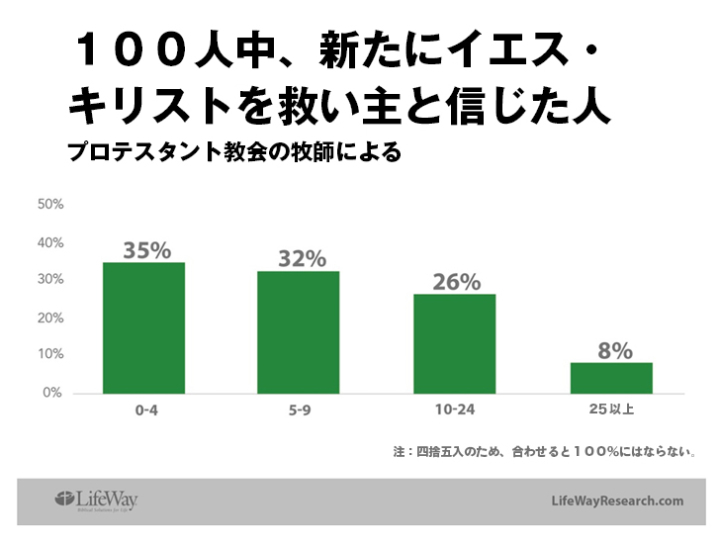教会の回心
[toggle]Church conversions[/toggle]多くの教会で礼拝出席者数が伸びない理由は、昨年新たにキリストに従う決心をした人がいなかったことに起因する。2018年にイエス・キリストを救い主として受け入れた人が10人未満だったと言っているのは44%の牧師で、8%は「1人もいなかった」とした。
[toggle]The lack of growth in worship attendance in most churches is matched by a lack of new commitments to Christ last year.Fifty-four percent of pastors say fewer than 10 people indicated a new commitment to Jesus Christ as Savior in 2018, including 8 percent who had none. [/toggle]

しかし、ある意味でこれらの数字には、もっと深い伝道の問題が隠されている。どんな規模の教会でも、100人の礼拝出席者がいると数字を揃えて、その中で何人の回心者がいたかを見ると、10人未満というのは67%。5人未満というのは3分の1(35%)だった。
[toggle]In some ways, however, those numbers mask deeper evangelistic issues. When evaluating churches based on the number of conversions per 100 attendees, 67 percent had fewer than 10 per 100 people attending their church. Around a third (35%) had fewer than five new commitments for every 100 people attending their worship services. [/toggle]10人以上と答えたのは、小さな教会(礼拝出席が50人未満)では46%。250人以上の出席者がある教会では、たった18%しかこの基準を満たせなかった。
[toggle]Forty-six percent of smaller churches (fewer than 50 in worship services) say they had 10 conversions or more for every 100 in attendance, while only 18 percent of churches 250 and above meet that benchmark. [/toggle]回心者が与えられるかどうかについては、福音派と主流派の教会では大きな違いはなかったが、教派間での違いは存在する。
[toggle]While there are no major differences between evangelical and mainline churches in terms of new converts, denominational differences do exist. [/toggle]
米国テキサス州ヒューストンにあるペンテコステ派のメガチャーチ、レイクウッド教会の礼拝(写真:ToBeDaniel)
「昨年の礼拝出席者100人に対して10人以上決心者があった」と言うのは、ペンテコステ派が多く(57%)、続いてルター派(39%)、ホーリネス(38%)、バプテスト(35%)と並ぶ。
[toggle]A majority of Pentecostal pastors (57%) say they saw 10 or more new commitments to Christ in their church last year per 100 attendees. The next closest denominations are Lutherans (39%), Holiness (38%), and Baptists (35%).[/toggle]「2018年、礼拝出席者100人のうち10人以上の決心者が与えられた」としたのはメソジスト25%、長老改革派23%だ。メソジストの牧師の半分(50%)は、「昨年決心した人が5人未満だった」とした。
[toggle]A quarter of Methodist (25%) and Presbyterian or Reformed pastors (23%) say they had 10 or more new commitments to Jesus in 2018 per 100 attendees. Half of Methodist pastors (50%) had fewer than five new commitments last year. [/toggle]「教会が健康的かどうかを深く探るために、さらに多くの研究がなされてきました。しかし、会堂に集まる人の数、献金額、回心者の数を見て観察するという手法は、今でも役に立ちます。戦略やプログラム、大まかな方針も、教会成長の軌道によって異なります」とマコーネル氏は言う。
[toggle] “Much work has been done to go deeper on measuring church health,” said McConnell. “But it is still helpful to look at the observable factors of ‘noses, nickels, and new commitments.’ Strategies, programs and rules-of-thumb work differently depending on the trajectory of a church.” [/toggle]調査方法:ライフウェイ・リサーチ社により2019年1月14~30日、1000人の牧師に電話調査が行われた。すべてのプロテスタント教会のリストから、教会の規模別に無作為に選ばれた教会が対象となった。定員数は、教会規模の正しい割合を出すために使用された。人数を正確に反映するため、回答は地域ごとに加重配分されている。すべての質問は主任牧師(教会によって呼び名は違うが)に聞いた。これらの回答は95%の正確さがあり、誤差は3・2%以内。誤差の可能性はサブグループで高い。
[toggle]Methodology: A phone survey of 1,000 Protestant pastors was conducted by LifeWay Research January 14 – 30, 2019. The calling list used a random sample stratified by church size, drawn from a list of all Protestant churches. Quotas were used to maintain the correct proportion of each church size. Responses were weighted by region to more accurately reflect the population. Each interview was conducted with the senior pastor, minister or priest of the church called. The sample provides 95 percent confidence that the sampling error does not exceed plus or minus 3.2 percent. Margins of error are higher in sub-groups. [/toggle]執筆者のアーロン・アールズはライフウェイ・リサーチ社のライター。
本記事は「クリスチャニティー・トゥデイ」(米国)より翻訳、転載しました。翻訳にあたって、多少の省略をしています。
